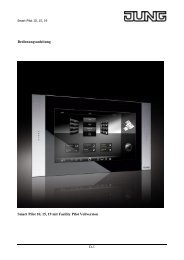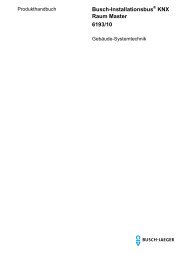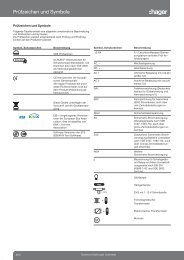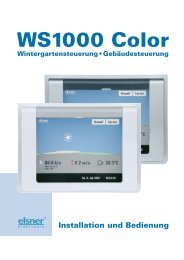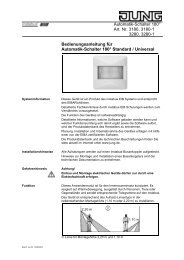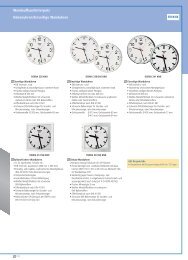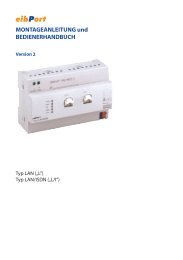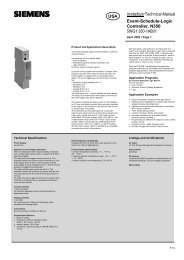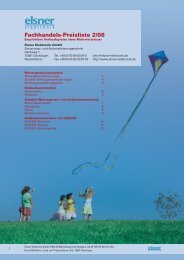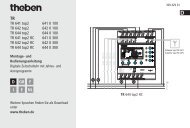You also want an ePaper? Increase the reach of your titles
YUMPU automatically turns print PDFs into web optimized ePapers that Google loves.
4.2.4.4.2 Acknowledgement and message list<br />
Acknowledgement of a fault message<br />
A fault message can either be acknowledged internally via function button 3 of the message<br />
window (internal acknowledgement) or via the bus through a separate<br />
1 bit communication object (external acknowledgement). A fault message must be acknowledged<br />
to switch the piezo buzzer off and to close the message window shown when a fault occurs..<br />
i The acoustic signalling of a fault using the piezo buzzer or by displaying the message window<br />
is parameter-dependent (see chapter 4.2.4.4.1. Creating fault messages and the message<br />
window).<br />
With internal acknowledgement, the parameter "Acknowledgement via button" in the parameter<br />
group of a fault defines the following acknowledgement properties of the third function button<br />
"Acknowledgement" in the message window...<br />
- When the function button 3 is pressed, the acknowledgement is only processed internally.<br />
No information is sent to other devices.<br />
- "Sends object value 0", "Sends object value 1" settings: an additional "acknowledgement<br />
object" is made visible. When the button is pressed, the acknowledgement is also sent to<br />
other devices via this 1 bit object. The telegram polarity of the acknowledgement object is<br />
directly defined by the "Acknowledgement via button" parameter.<br />
- "Disabled" settings: internal acknowledgement using function button 3 of the message window<br />
is deactivated. This means that function button 3 does not have a function.<br />
An additional 1 bit communication object must be enabled for external acknowledgement. If the<br />
parameter "External acknowledgement through object value" is configured to "1 telegram" or<br />
"0 telegram", then the fault message can also be acknowledged by other KNX / EIB devices. In<br />
this case, the "Acknowledgement receipt object" is display in the ETS plug-in.<br />
If a fault message has been acknowledged, this does not mean that the cause of the fault has<br />
automatically been eliminated. For this reason, the fault signal may be presented again after a<br />
set time. The cause of a fault is only considered to be eliminated when a telegram is received<br />
via the fault message object containing a polarity inverse to that in the telegram activating the<br />
fault message (parameter-dependent).<br />
Acknowledgement can also cause an automatic switch to one of the projected user pages in the<br />
panel. As with all other page openings, this page must be created in the ETS plug-in so that a<br />
page can be specified with the "Open page" parameter and a jump can be executed.<br />
i When the parameter "Open message window" of a fault message is set to "No" and the<br />
acoustic signal is activated, the piezo buzzer will sound when an appropriate fault message<br />
telegram arrives, but no message window opens. Acknowledgemet is then only possible<br />
externally using the appropriate communication object. For this reason, the external acknowledgement<br />
must be configured and used in such a configuration.<br />
i When a fault message is acknowledged, an acknowledgement event is logged in the message<br />
list (see next section). This logging operation only takes place when a fault message<br />
is acknowledged using function button 3 of the message window or is acknowledged externally<br />
and not when a message window is closed using button 4 "Acknowledgement /<br />
Back".<br />
Order-No. 7574 00 1X<br />
Software "...590101"<br />
Functional description<br />
Page 81 of 222




